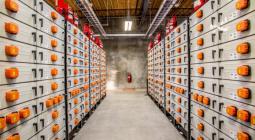4 maps that show who’s being left behind in America’s wind-power boom.
Why does a huge swath of the country have hardly any wind turbines at all?
President Trump has been mocking wind power a lot lately. In an interview with Fox News’s Sean Hannity, he asserted that the United States, “would have been powered by wind, which wouldn’t have worked by the way because it only blows sometimes and lots of problems come about.” Then, in a speech Tuesday, he claimed that sounds made by wind turbines cause cancer. (There is no evidence whatsoever this is true.)
In fact, wind turbines have cropped up like dandelions across large areas of the US, and thousands more are coming. The US Department of Energy projects that we’ll have 404 gigawatts of wind energy capacity across the country by 2050, up from 90 GW today. Since overall electricity demand is expected to hold steady, that would fulfill more than one-third of the country’s needs.
“Wind power is an important part of America’s energy strategy,” said Trump’s Secretary of Energy Rick Perry recently, while announcing $28.1 million in new funding for wind R&D.
Texas alone, with 22.6 gigawatts installed, would rank sixth in the world today in total wind capacity if it were its own country.
But wind power isn’t exploding everywhere across this great land of ours. Vast swaths of the country have been left out of the wind energy revolution, as you can see in this map of installed wind capacity by state:
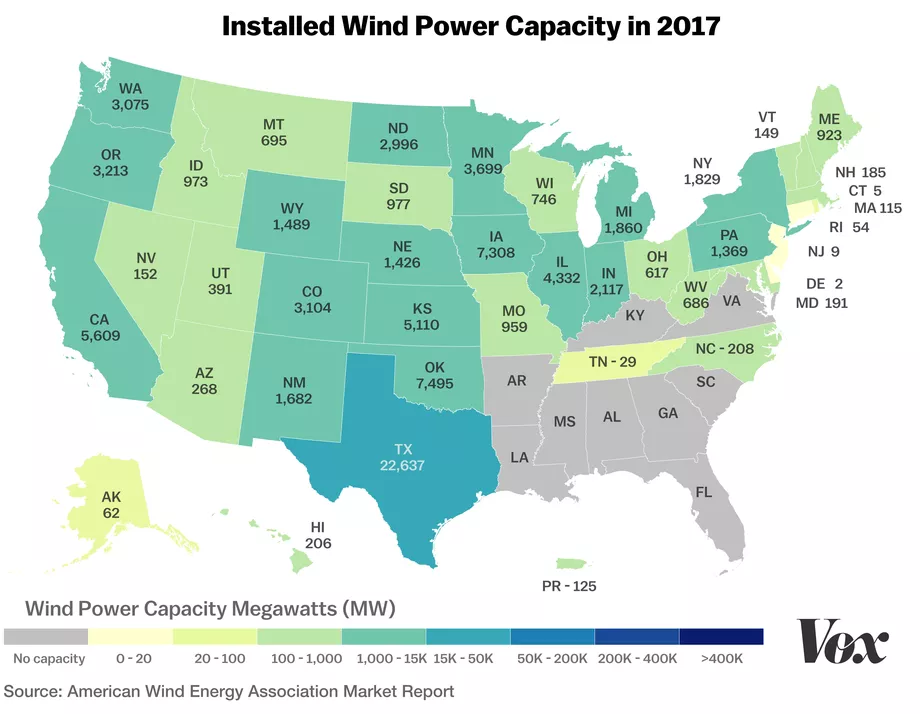
And when you look at how much wind we’ve built per state since 1999, you can see how quickly wind has boomed in some areas, while others are stuck in the doldrums:

Right next to wind king Texas, you have 11 states with little to no installed wind power, including Louisiana, Florida, and Georgia.
And when you map where the clusters of wind turbines are physically located, the hole in the southeastern US becomes even more stark:
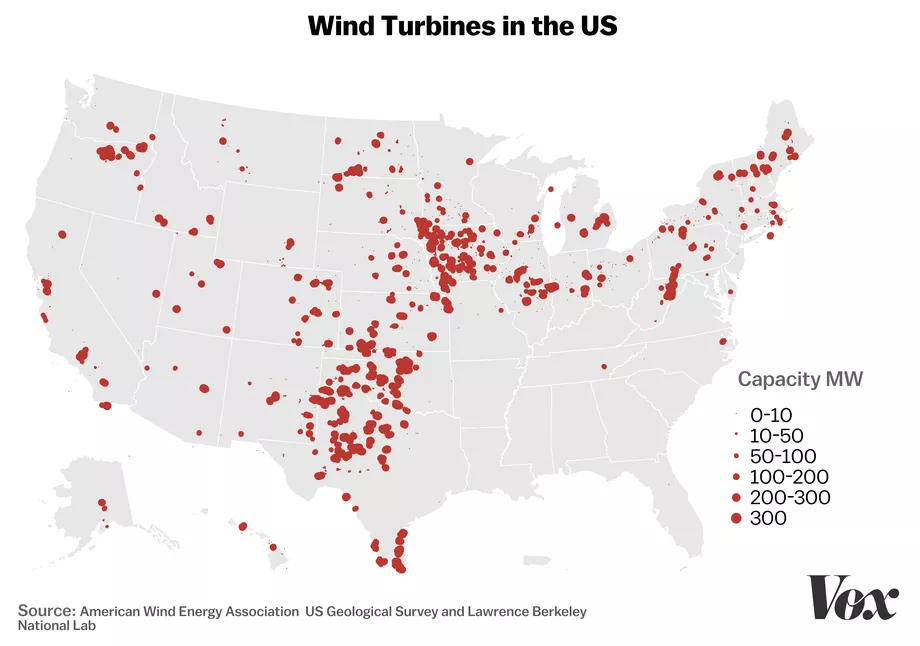
The above map of 57,636 wind turbines across the US is drawn from a terrific interactive website launched in April 2018 by the US Geological Survey, the American Wind Energy Association, and the Lawrence Berkeley National Laboratory. And it pulls data from the US Wind Turbine Database, a years-long effort to map the gale of wind power sweeping the country.
It’s the best evidence we have that many parts of the US are being left behind in the wind power boom.
States don’t have equal wind resources or incentives
I wanted to understand what was going on here, so, naturally, I went looking for more maps. And it turns out there are several reasons states like Alabama and Georgia are so far apart from states like Nebraska and Wyoming, and why it’s unlikely that they’ll be able to close the gap anytime soon.
This map of average wind speeds at a height of 80 meters, or 262 feet — the height that matters for most commercial wind turbines — illustrates one big reason for America’s wind disparity:
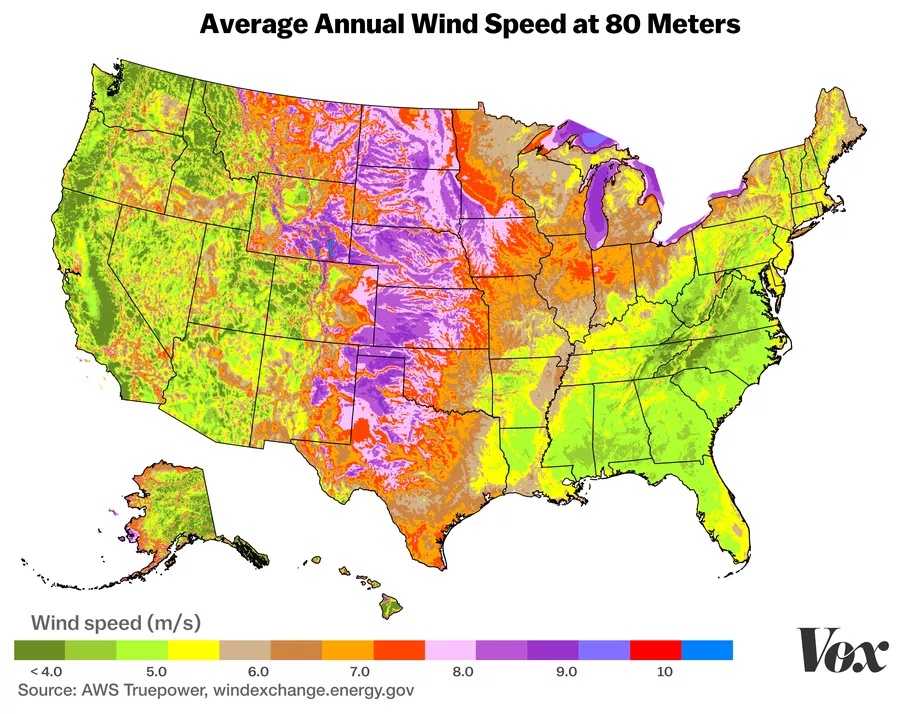
The areas in purple and red — the Great Plains states — have the fastest wind speeds and therefore the most wind energy available for harvest. The Southeast, clearly, has a lot less wind.
“The main difference between the southeastern US and the rest of the country is the intensity of the resource,” said Paul Veers, chief engineer at the National Wind Technology Center at the National Renewable Energy Laboratory. “Wind power is very sensitive to the wind speed, more than you might guess.”
The power you get from a wind turbine has a cubic relationship to the wind speed, he says. If you double the wind speed, you get eight times more power. So it makes sense that utilities are planting wind turbines in the places with the most wind.
Still, there are plenty of wind turbines in less breezy states out west like Idaho, which has 973 MW of capacity. So why else is the Southeast so devoid of wind power?
Policies are a big part of it.
The major driver to invest in wind in many states is renewable portfolio standards, which mandate a minimum amount of electricity to come from renewable sources, like hydroelectric, wind, solar, and geothermal power plants. While federal incentives like the production tax credit, which benefits wind energy installations, apply across the country, state-level programs make a major difference on the ground.
“The states that have stronger RPSs are the places where you see renewables being deployed more actively,” said Ian Baring-Gould, a technology deployment manager at the National Renewable Energy Laboratory. “In places that don’t have RPSs, the utilities don’t have as much motivation to develop renewables.”
Take a wild guess which states don’t have RPSs:
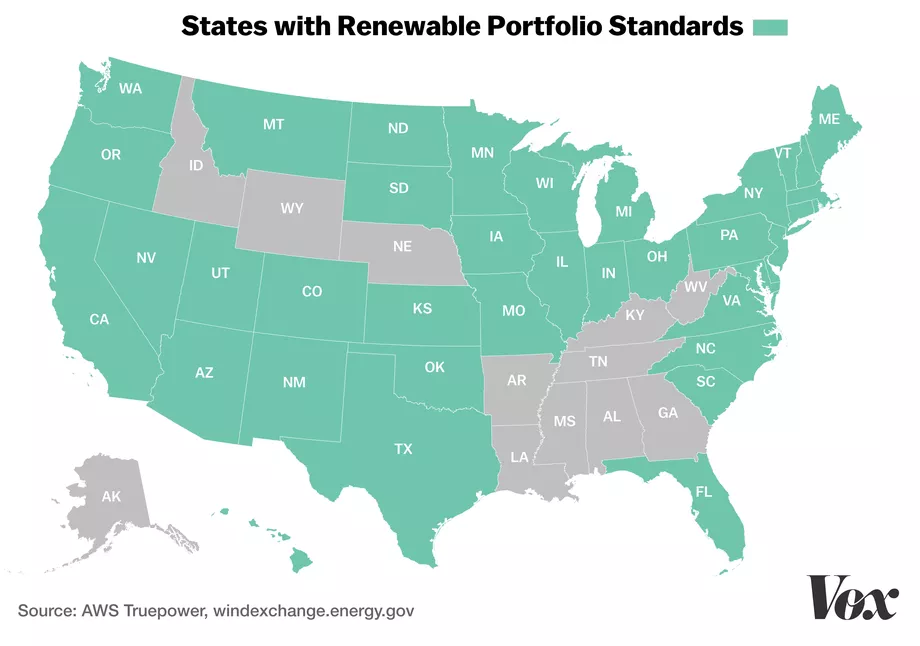
States like Nebraska and Wyoming without RPSs still have an immense amount of wind available, so the economics of wind power still make sense even without a state mandate.
The South will rise eventually
The lack of an RPS doesn’t necessarily mean that a state is hostile to renewable energy. Every state in the country now has installed photovoltaic solar to some degree. But the upfront cost of building a turbine is much higher than it is for installing a PV panel, so every incentive counts when making the business case for deploying more wind energy.
Windier states allow for higher capacity factors from wind turbines, allowing them to sell more electricity and recuperate their upfront costs faster. Turning a profit gets much harder when there is less wind to begin with.
As a result, states like South Carolina, which has a renewable portfolio standard but limited wind resources, are meeting their goals with solar power.
Nonetheless, there are southeastern states without RPSs that do want wind energy, and there are ways for them to benefit from the massive growth of wind power.
For some utilities, the optimal strategy is to buy wind electricity from states where it is more abundant. Georgia Power, an investor-owned public utility serving most of Georgia, buys wind power Oklahoma via renewable energy certificates and long-term power sourcing contracts.
John Kraft, a Georgia Power spokesperson, told me in an email that the utility has a development initiative to add up to 1,600 megawatts of renewable energy capacity by 2021. But so far, solar energy has won out, with a power purchase agreement already signed in February to buy 510 megawatts in 2019.
“Under our [renewable energy request for proposals], the market has not offered us wind or biomass options that could compete with utility-scale solar projects in Georgia,” Kraft said.
So to get actual wind turbines to blossom in the Southeast, the generators themselves have to see their prices shrink further and get better at harnessing more marginal sources of wind. Here there’s some good news: The installed price for wind energy has fallen more than 90 percent since the 1980s and is continuing to drop as wind energy scales up. States like Georgia are also investigating their large potential for offshore wind.
The wind turbines themselves are also getting huge. Huuuuuuuge:

These larger turbines are better able to capture wind in less gusty areas, increasing the capacity factor. So as size goes up, costs come down, and utilities learn more about how to deploy wind energy, turbines will fill in more of the map.
“The trend across the entire country though has been the technology is adapting so that it can access lower and lower resource areas,” said Veers.
However, wind turbines will probably never be spread evenly across the country.
“It might change a little bit, but you are still going to be dealing with the fact that there are relatively inferior wind resources in those areas of the country,” said Ben Hoen, a research scientist at Lawrence Berkeley National Laboratory who worked on the wind turbine database. “It’s not as if renewable energy is not being deployed there; it’s just that the choice is based on economics, largely.”
6 April 2019



